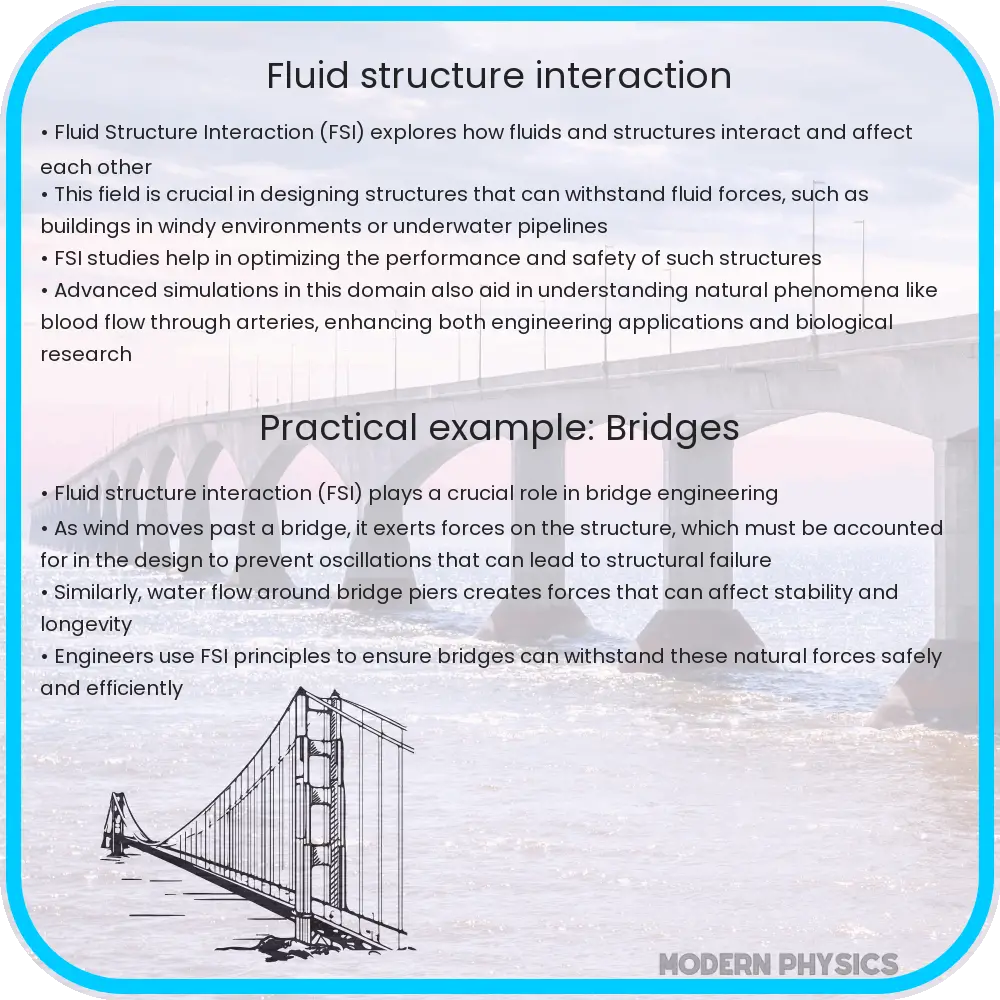Fluid-Structure Interaction (FSI) examines the dynamics between fluid flows (liquid and gas) and structural integrity, essential in engineering and design disciplines.

Understanding Fluid-Structure Interaction: Basics of Hydrodynamics in Analysis and Design
Fluid-Structure Interaction (FSI) is a fascinating area at the intersection of physics and engineering, dealing with the interaction between fluids (liquids and gases) and solid structures. This is crucial in designing buildings, vehicles, and other structures that come into contact with fluid flows. The study of FSI is essential in various fields such as civil engineering, aerospace, automotive, and maritime industries.
At its core, FSI involves two main sciences: fluid dynamics and structural dynamics. Fluid dynamics is the study of how fluids behave and interact with surrounding environments, while structural dynamics analyzes how structures respond to various forces, including those exerted by fluid flows.
Hydrodynamics: Key to Understanding Fluid Behavior
Hydrodynamics, a sub-discipline of fluid dynamics, specifically focuses on the behavior of liquids in motion. It plays a pivotal role in understanding how liquids apply forces to structures they encounter. The primary principles governing hydrodynamics include:
- Conservation of Mass: Often represented by the Continuity equation, which in its simplest incompressible flow form is expressed as ∇ * V = 0, where V represents the fluid velocity vector.
- Conservation of Momentum: Described by the Navier-Stokes equations, which account for the forces due to viscosity and pressure exerted within the fluid. The general form is ρ(∂V/∂t + (V * ∇)V) = -∇P + μ∇2V + F, where ρ is fluid density, V is velocity, P is pressure, μ is viscosity, and F represents external forces.
- Energy Conservation: Important when considering thermal effects and compressibility of the flow, often modeled by the Energy equation.
These principles are essential for predicting how liquids will move and interact with structures, which in turn helps in designing more efficient and safe structures.
Analysis and Design in FSI
When it comes to applying FSI in analysis and design, engineers and physicists use computational methods to simulate interactions between fluid flows and structures. Two main approaches are:
- Coupled Analysis: This method simultaneously solves the equations governing fluid flow and structural response. It is highly accurate as it fully accounts for the two-way interaction between the fluid and the structure. However, it is computationally intensive and requires sophisticated software and hardware resources.
- Decoupled Analysis: In this approach, the fluid dynamics and structural dynamics problems are solved sequentially. First, the fluid forces on the structure are calculated and then used as inputs to analyze the structural response. While less resource-intensive, it may not capture all the nuances of FSI, especially in cases where the interaction is highly dynamic and complex.
FSI analysis plays a crucial role in the design of bridges, skyscrapers, ships, and aircraft, among other structures. By understanding how structures respond to fluid forces, engineers can predict potential failures and optimize designs for durability and safety.
Practical Applications of Fluid-Structure Interaction
One of the most beneficial aspects of understanding FSI is its application in real-world scenarios. Practical examples include:
- Bridge Design: Engineers use FSI to estimate the impact of wind and water currents, which helps in designing bridges that can withstand natural forces over time.
- Aircraft Design: FSI is crucial for designing aircraft that can endure varying air pressures and temperatures while maintaining structural integrity and safety.
- Marine Engineering: In the design of ships and underwater pipelines, FSI analysis helps determine how these structures will respond to ocean currents and pressure, ensuring they are built to last in harsh marine environments.
By integrating FSI principles, engineers not only enhance the safety and durability of structures but also contribute to innovative design solutions that meet modern engineering challenges.
Challenges and Future Prospects in Fluid-Structure Interaction
Despite the significant advancements in FSI, there are ongoing challenges that continue to drive research in this field. These include:
- Real-time Simulation: Developing methods to provide accurate real-time predictions during extreme conditions such as hurricanes or earthquakes.
- Material Complexity: Understanding the behavior of non-traditional materials under the influence of fluid dynamics to improve the sustainability and efficiency of structures.
The future looks promising as technology advances, such as enhanced computing power and artificial intelligence, are expected to solve some of these complex problems, opening new avenues for optimizing and innovating in engineering design.
Conclusion
Fluid-Structure Interaction (FSI) is a pivotal study area that merges fluid dynamics with structural dynamics to ensure the safety, longevity, and efficacy of various structures impacted by fluid environments. From understanding basic principles like hydrodynamics to applying these concepts in designing robust structures like bridges and aircraft, FSI continues to be an indispensable part of engineering. As technologies evolve, the scope for applying FSI broadens, enabling the creation of structures that are not only structurally sound but also innovative and suited to meet future needs. Therefore, embracing FSI principles is essential for pushing the boundaries of what is achievable in both engineering and architecture.
